From the writer healthiergang , personal trainer.
Push-ups and push-ups on the ground
Before talking about the various types of pushups, the muscles they involve and the correct executions, let's explain the difference between "pushups and pushups".
Commonly we speak of Push-ups and Push-ups referring to the same type of exercise; this is not correct as we are talking about two completely different workouts.
The main difference is the following:
- Bending: movement that allows the approach of two joint heads with support on a surface - ground, wall, trx, etc. .. (bending on the arms).
- Flexion: movement that allows the joint heads to come together without support (biceps with dumbbells)
Push-ups are a great exercise for working out the pectoral and triceps muscles by simply leveraging the body's natural weight (similar exercise).
Types of pushups
Let's talk about the different variations of this exercise available.
1. Push Up
The first of the types of pushups we're going to talk about are push ups. The muscles mainly involved are: pectoralis major, triceps and anterior head of the deltoid.
Also involved are: serratus anterior, sub scapular and all the musculature that is part of the CORE.
For a correct execution, position yourself in prone position on an exercise mat or directly on the ground, feet together, arms spread with the tips of the fingers pointing forward, distance slightly greater than that of the shoulders.
Start with your arms outstretched and slowly descend until you touch the ground; with the pectoral it is important that the pelvis does not flex towards the ground; your back should be straight and stiff like a board.
When you get close to the ground, go back upwards trying to isolate the work of the pectoral muscle.
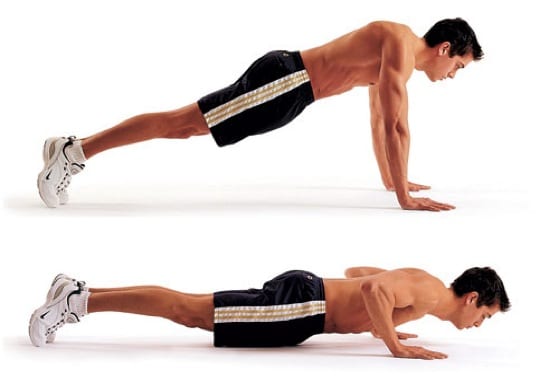
The most common mistakes made are:
- arch your back while pushing to help perform the exercise;
- lift the buttock upward;
- perform half bending of the arms;
- descend not simultaneously with the shoulders;
- excessive speed of execution.
This exercise is indicated for athletes who have already started as it requires excellent control of the muscles, especially the muscles that make up the CORE.
2. Push-ups on the ground on the arms, feet high
Let's move on to another one of the types of push-ups available for novice / novice athletes.
Keep your knees flat on the ground to reduce the load, arms up on a support.
For those who have further difficulties, it is possible to use the wall variant: in an upright position about a step and a half away from the wall, hands on the wall, feet close to each other.
The movement is the same as the classic push-ups on the arms.
Once you are able to perform the exercise on the wall and then on the ground on a support, you can move on to the exercise that sees knees and hands on the ground and finally to the final exercise or the classic push-ups on the arms.
In this variant the feet are placed higher than the shoulder line. The movement is the same as the basic exercise.
In this case, however, the work focuses more on the upper and middle part of the pectoral (clavicular bundles). The muscles involved in the execution are pectoralis major (clavicular bundles), triceps and anterior head of the deltoid.

3. Push-ups on the ground on the arms, feet down, hands up
One of the types of push-ups is the push-up, feet down, and hands up. In this variant the hands are positioned high up, on a bench, or step, or cube box, while the feet are positioned on the ground.
The execution is identical to that of the previous exercise but in this case the work focuses more on the inferior and medial bundles of the pectoral.
The muscles involved in the exercise are: pectoralis major (lower pectoral bundles), triceps and anterior head of the deltoid.
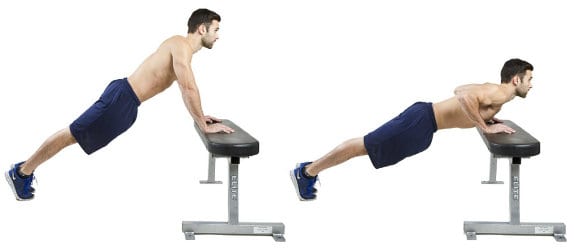
Other variants, without the use of special tools, are:
- push-ups on the arms, hands together (diamond push up);
- asymmetrical push-ups (asymmetrical push-ups);
- push-ups on the arms movement of the knees (spider push up);
- pushups with one leg raised (alternate leg push ups);
- pushups with upward momentum (plyometric push up);
Of course, the combination possibilities are endless.
Here I have listed the best known.
Let's now analyze the types of bending with the use of tools.
4. Medball push up
Another type of push-up we're going to talk about is the medball push up. Body position identical to that of the basic exercise.
Unlike it, place your hands on top of two medballs (one in each hand). In this case there will be a greater work of the stabilizing muscles of the arm, wrist, scapula and humerus, therefore with greater activation of the chest, shoulders, triceps kinetic chain.
This is due to a destabilizing action due to the two medballs.
This exercise is not recommended for beginners as it requires high body control, balance, strength and coordination.
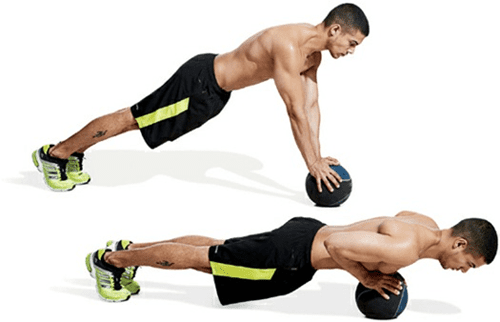
5. Cross push up/diamond push up
Starting position similar to that of the basic exercise but in this case place one hand on the ground and one hand on top of a medball.
Perform the push-up and perform the ascent phase in an intense manner and quickly reverse the position of the hands and arms (the hand that was previously on the ball passes to the ground and vice versa).
The muscles involved are the same as in the other variants but with a greater muscle strain due to the greater muscle stretch.
The rhomboids, stabilizers of the scapula and of the rotator cuff, are also stressed.
This is a great exercise that positively stimulates motor control, balance and proprioception.
With a medball it is also possible to perform the variant with the passage of both hands from the ground to the medball and vice versa, similar to the push-ups on the arms with hands together.
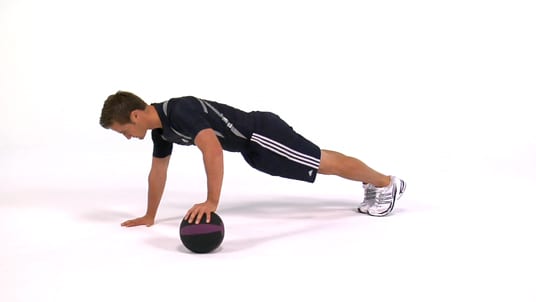
Some variations to medball pushups can be performed with the following tools:
- pushups with two kettlebells / one kettlebell (kettlebell push up);
- push-ups with two push-up bars / one push-up bar;
- push-ups with two sandbags / one sandbag (sandbag push up).
6. Balance board push up
With this tool it is possible to perform all the free body variants (listed at the beginning) with the difference that, thanks to the balance board, motor control, balance and proprioception are stimulated more than the other exercises listed above.
When using this tool it is important to pay close attention to the elbow and wrist joints which are certainly put to the test.
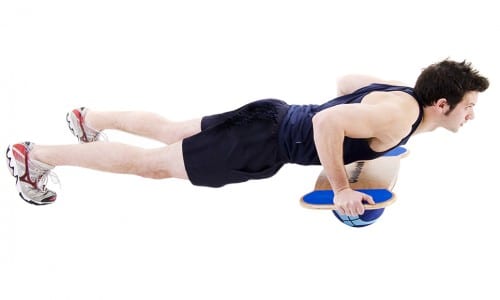
7. TRX push up
Also in this case, many variations of pushups are possible (for example: high foot or low foot pushups, pushups with one leg raised, etc.) which can be used by both inexperienced athletes and more advanced athletes.
With the use of the TRX motor control, balance, proprioception, the musculature of the core. The various kinetic chains are fully activated (based on the type of exercise used).
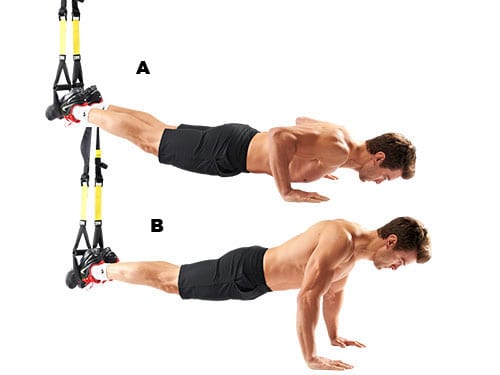
Obviously when using gear like TRX, medball, sandbag etc. A wide variety of exercises is possible and a little imagination is enough to create an efficient and effective workout.
My advice is always to turn to a professional, especially when it comes to inexperienced and novice athletes.
What are the types of pushups that exist?
There are different types of push-ups, including Push Ups, Arm and Feet High Pushups, Arm Pushups with Low Feet and Hands High, Medball push up, Cross push up / diamond push up, Balance board push up, TRX push up.
How do you perform a push up?
For a correct execution, position yourself in prone position on an exercise mat or directly on the ground, feet together, arms spread with the fingertips facing forward, a distance slightly greater than that of the shoulders.
Start with your arms outstretched and slowly descend until you touch the ground; with the pectoral it is important that the pelvis does not flex towards the ground; your back should be straight and stiff like a board.
When you get close to the ground, go back upwards trying to isolate the work of the pectoral muscle.
How do you perform pushups on the floor on high arms and feet correctly?
Keep your knees flat on the ground to reduce the load, arms up on a support.
For those who have further difficulties, it is possible to use the wall variant: in an upright position about a step and a half away from the wall, hands on the wall, feet close to each other.
The movement is the same as the classic push-ups on the arms.
Once you are able to perform the exercise on the wall and then on the ground on a support, you can move on to the exercise that sees knees and hands on the ground and finally to the final exercise or the classic push-ups on the arms.
In this variant the feet are placed higher than the shoulder line. The movement is the same as the basic exercise.
In this case, however, the work focuses more on the upper and middle part of the pectoral (clavicular bundles). The muscles involved in the execution are pectoralis major (clavicular bundles), triceps and anterior head of the deltoid.
How do you correctly perform the push-ups on the arms with feet down and hands up?
One of the types of push-ups is the push-up, feet down, and hands up. In this variant the hands are positioned high up, on a bench, or step, or cube box, while the feet are positioned on the ground.
The execution is identical to that of the previous exercise but in this case the work focuses more on the inferior and medial bundles of the pectoral.
The muscles involved in the exercise are: pectoralis major (lower pectoral bundles), triceps and anterior head of the deltoid.
How do you perform the Medball push up correctly?
Another type of push-up we're going to talk about is the medball push up. Body position identical to that of the basic exercise.
Unlike it, place your hands on top of two medballs (one in each hand). In this case there will be a greater work of the stabilizing muscles of the arm, wrist, scapula and humerus, therefore with greater activation of the chest, shoulders, triceps kinetic chain.
This is due to a destabilizing action due to the two medballs.
This exercise is not recommended for beginners as it requires high body control, balance, strength and coordination.


























